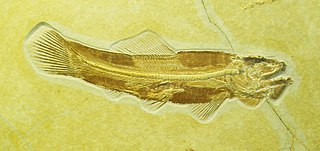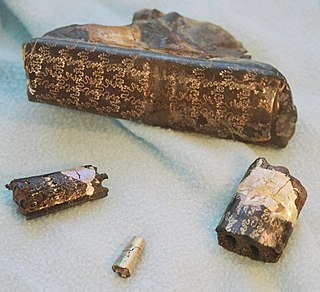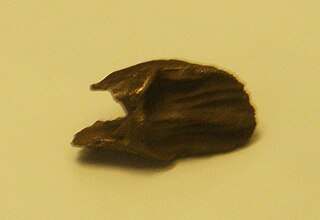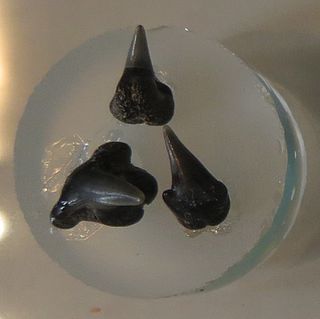 W
WAglaocetus is a genus of extinct mysticete known from the Miocene of Patagonia, the US Eastern Seaboard, Japan and the Low Countries. It was once considered a member of Cetotheriidae along with many other putative cetotheres, but was recently recognized as representing a distinct family from true Cetotheriidae.
 W
WAmiopsis is an extinct genus of prehistoric bony fish belonging to the family Amiidae.
 W
WAtrypa is a genus of brachiopod with shells round to short egg-shaped, covered with many fine radial ridges, that split further out and growthlines perpendicular to the costae and 2-3 times wider spaced. The pedunculate valve is a little convex, but tends to level out or even become slightly concave toward the anterior margin. The brachial valve is highly convex. There is no interarea in either valve. Atrypa was a cosmopolitan and occurred from the late Lower Silurian (Telychian) to the early Upper Devonian (Frasnian). Other sources expand the range from the Late Ordovician to Carboniferous, approximately from 449 to 336 Ma. A proposed new species, A. harrisi, was found in the trilobite-rich Floresta Formation in Boyacá, Colombia.
 W
WBaculites is an extinct genus of cephalopods with a nearly straight shell, included in the heteromorph ammonites. The genus, which lived worldwide throughout most of the Late Cretaceous, was named by Lamarck in 1799.
 W
WBalaenotus is an extinct genus of cetaceans from the Pliocene of Belgium.
 W
WComposita is an extinct brachiopod genus that lived from the Late Devonian to the Late Permian. Composita had a cosmopolitan global distribution, having lived on every continent except Antarctica. Composita had a smooth shell with a more or less distinct fold and sulcus and a round opening for the pedicle on the pedicle valve. Composita is included in the family Athyrididae and placed in the subfamily Spirigerellinae.
 W
WCraspedodon is an extinct genus of ornithischian dinosaur, possibly a ceratopsian. It lived during the Late Cretaceous, in what is now Belgium. Only a few teeth have ever been found, which were described as similar to those of Iguanodon. Craspedodon lonzeensis, described by Louis Dollo in 1883, is the type species, although it is considered a nomen dubium since it is based on fragmentary material. It was long thought to be an iguanodontian, but restudy suggested that it was actually a neoceratopsian, perhaps closer to Ceratopsoidea than Protoceratopsidae. If the reidentification is correct, Craspedodon would be the first neoceratopsian known from Europe.
 W
WCummingella is a genus of proetid trilobite in the family Phillipsiidae that lived from the earliest Carboniferous until the last species' extinction in the Middle Permian. Fossils have been found in corresponding marine strata of Western Europe, the United Kingdom and the United States.
 W
WCyrtospirifer is an extinct genus of brachiopods. The fossils are present in the Middle and Upper Devonian.
 W
WDiacodexis is an extinct genus of small herbivore mammals belonging to the family Dichobunidae which lived in North America, Europe and Asia from 55.4 mya to 46.2 mya and existing for approximately 9.2 million years .
 W
WDunkleosteus is an extinct genus of arthrodire placoderm fish that existed during the Late Devonian period, about 358–382 million years ago. The name Dunkleosteus combines the Greek ὀστέον, osteon, meaning "bone", and Dunkle, in honor of David Dunkle of the Cleveland Museum of Natural History. It consists of ten species: D. terrelli, D. belgicus, D. denisoni, D. marsaisi, D. magnificus, D. missouriensis, D. newberryi, D. amblyodoratus, and D. raveri; some of which are among the largest placoderms to have ever lived. The largest species, D. terrelli grew up to 8.79 m (28.8 ft) long and 4 t in weight. Dunkleosteus could quickly open and close its jaw, like modern day suction feeders, and had a bite force of 6,000 N at the tip and 7,400 N at the blade edge. Numerous fossils of the various species have been found in North America, Poland, Belgium, and Morocco.
 W
WEostegostoma is an extinct genus of prehistoric cartilaginous fish from the Eocene epoch of Belgium.
 W
WFavosites is an extinct genus of tabulate coral characterized by polygonal closely packed corallites. The walls between corallites are pierced by pores known as mural pores which allowed transfer of nutrients between polyps. Favosites, like many corals, thrived in warm sunlit seas, feeding by filtering microscopic plankton with their stinging tentacles and often forming part of reef complexes. The genus had a worldwide distribution from the Late Ordovician to Late Permian.
 W
WGracilocyon is an extinct genus of miacid carnivoran which existed in United States, in Belgium and in the United Kingdom during the earliest Eocene. It was first named by Thierry Smith and Richard Smith in 2010 and the type species is Gracilocyon winkleri.
 W
WHylaeobatrachus is an extinct genus of prehistoric salamander, known from the Early Cretaceous of Europe. The type species H. croyii is known from the Sainte-Barbe Clays Formation at the Iguanodon locality of Belgium, and was described by Louis Dollo. An indeterminate species is also known from Las Hoyas, Spain. Both localities are of Barremian age.
 W
WIguanodon, named in 1825, is a genus of ornithopod dinosaur that existed roughly halfway between the first of the swift bipedal hypsilophodontids of the mid-Jurassic and the duck-billed dinosaurs of the late Cretaceous. While many species have been classified in the genus Iguanodon, dating from the late Jurassic Period to the early Cretaceous Period of Asia, Europe, and North America, taxonomic revision in the early 21st century has defined Iguanodon to be based on one well-substantiated species: I. bernissartensis, which lived from the late Barremian to the earliest Aptian ages in Belgium, Spain, Germany, England, Portugal and possibly elsewhere in Europe, between about 126 and 122 million years ago. Iguanodon were large, bulky herbivores. Distinctive features include large thumb spikes, which were possibly used for defense against predators, combined with long prehensile fifth fingers able to forage for food.
 W
WLeptolepis is an extinct genus of teleost fish that lived in freshwater and marine environments from the Middle Triassic period until the Early Cretaceous. The genus is one of the earliest recognized teleost genera.
 W
WThe Lier mammoth is the skeleton of a mammoth that was found in 1860 near the Dungelhoeffkazerne in Lier in the Province of Antwerp of Belgium, while digging the diversion canal of the Nete. Its importance was recognised by a military doctor stationed in Lier, François-Joseph Scohy, and the skeleton was excavated, mounted and in 1869 for the first time shown to the public. This was a first skeleton of a mammoth for Western Europe. Only the museum of Saint Petersburg was already in possession of a mammoth skeleton. Because the skeleton is not complete, some bones were recreated in wood.
 W
WOtodus aksuaticus is an extinct species of large shark in the family Otodontidae which may represent a transitional species between the genus Otodus and the genus Carcharocles. They are similar in overall morphology to Otodus obliquus except they have serrations on their cusps and blade. It is sometimes placed in the genus Otodus. It is mainly found in the Ypresian stage of the Eocene epoch. They have been found in the Woodstock Member of the Nanjemoy Formation of Maryland and Virginia and Ypresian sediments in Aktulagay, Kazakhstan as well as the Ypres clay in Belgium and the London Clay in the United Kingdom.
 W
WPlatystrophia is an extinct genus of brachiopods that lived from the Ordovician to the Silurian in Asia, Europe, North America, and South America. It has a prominent sulcus and fold. It usually lived in marine lime mud and sands.
 W
WScaldicetus is an extinct genus of highly predatory macroraptorial sperm whale. Although widely used for a number of extinct physeterids with primitive dental morphology consisting of enameled teeth, Scaldicetus as generally recognized appears to be a wastebasket taxon filled with more-or-less unrelated primitive sperm whales.